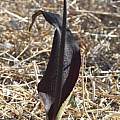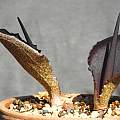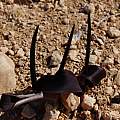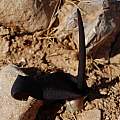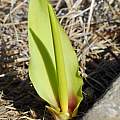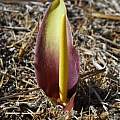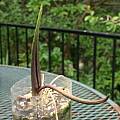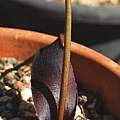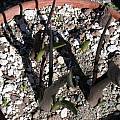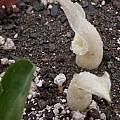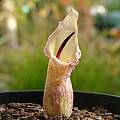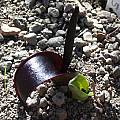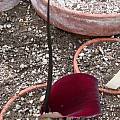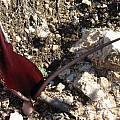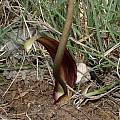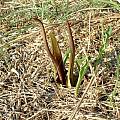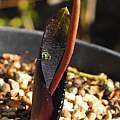Biarum Schott is a genus of the Araceae family, spread from the Mediterranean basin to the Middle East. Most species flower in late fall (October to November), with the sessile flowers appearing mostly before the foliage. Like many aroids, they have developed an intense smell to attract carrion flies as pollinators. For more information about this genus consult the International Aroid Society.
Biarum angustatum (Hook.f.) N.E.Br. is native to coastal areas of Syria, Lebanon, and Israel, where it grows in sand at sea level. It is the first Biarum species to bloom in the region starting in early October. It is recognized easily by the narrow 'leg' and a distinctive deep aubergine color. Photos one and two are taken in Oron's collection and in its habitat in Northern Israel by Oron Peri. Photos three and four were taken by Jane McGary in Jordan, flowering in the bare ground after severe drought.
Biarum auraniticum Mouterde is a very rare species endemic to the Hauran region in SE Syria. It is the only species in this genus to have a yellow spadix and spathe in different shades of yellow or rusty/yellow. It flowers in mid October to mid November. Photos were taken in the Golan Heights, Syria by Oron Peri.
Biarum carduchorum (Schott) Engl. is native from Turkey to Iran and blooms in summer. The first photo was taken on June 2, 2006, by Jim McKenney in his zone, 7 Montgomery County, Maryland garden; the second photo was taken by Oron Peri in his collection.
Biarum carratracense (Willk.) Font Quer is from southern Spain. It is photographed by Jane McGary in a bulb frame.
Biarum davisii Turrill is native to Crete and southwestern Turkey where it grows in rocky, well-drained sites. It flowers in late summer to early fall. The inflorescence appears at ground level and is prettier than many in this genus, being white to cream with pink flecks, and about 4 inches high. In cultivation it requires a hot, dry summer dormancy and protection from excess wet and freezing in winter, though it will tolerate temperatures down to about 25 degrees F. It often fails to bloom and being crowded in the pot is recommended, although the plants shown are flowering just 2 months after being separated and repotted. Like most Biarum species, it makes numerous offsets, which can be removed in midsummer. Photographed in a bulb frame by Jane McGary.
Biarum davisii ssp. marmarisense P.C.Boyce (no longer recognized by some authorities as deserving subspecies recognition) is native to SW Turkey. This plant is flowering in a pot, October 2004, 3 weeks after purchasing by mail-order. The flower is about 3" (7 cm) high and is said to be fragrant. Photo by Brian Whyer.
Biarum dispar (Schott) Talavera is from the Iberian Peninsula and Sardinia. This specimen has a spadix about 3 inches (7.5 cm) tall. It is grown in an unheated bulb frame, not completely dried out in summer. Photo by Jane McGary.
Biarum pyrami (Schott) Engl. is native to Turkey and Iran. This plant was grown from seed purchased from the Czech company Euroseeds, sown in 1997, germinated in 1999, and here flowering for the first time in October 2003. The spadix is about 15 cm tall; for scale, the plant is in a 15 cm diameter (6 in) pot. It is grown in a bulb frame, dry in summer. The second photo was taken in the Peloponnese, Greece, in late October 2006. It shows one of a colony of plants growing on a dry, sunny bank in bare soil with a little scrub. The inflorescence on some of the wild plants was much larger than seen in cultivation, suggesting that a wide, deep root run will be beneficial for cultivated specimens. Photos by Jane McGary.
Biarum tenuifolium (L.) Schott is a small plant, virtually impossible to see. Its leaves are pretty similar to many common weeds and the flower is mimetic, being the same colour of the surrounding soil. Only its 'unique' scent reveals its presence! Photos 1 and 2 were taken in habitat in Apulia, Italy, by Angelo Porcelli. The third photo from Oron Peri is of Biarum tenuifolium subsp. arundanum (Boiss. & Reut.) Nyman in cultivation in his collection.
